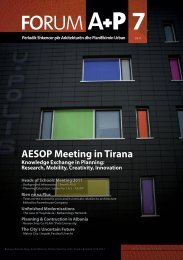Forum A+P 08
POLIS University publishes the “Forum A+P” journal, the only scientific and cultural magazine in the Albanian –speaking countries for the fields of architecture and territory planning. This magazine is recognized by the Ministry of Education and Science, the Academic Degrees Evaluation Committee and has an ISSN international registration code in France. The magazine is published in Albanian and English language and contains a package of scientific, informative articles and analysis.
POLIS University publishes the “Forum A+P” journal, the only scientific and cultural magazine in the Albanian –speaking countries for the fields of architecture and territory planning. This magazine is recognized by the Ministry of Education and Science, the Academic Degrees Evaluation Committee and has an ISSN international registration code in France. The magazine is published in Albanian and English language and contains a package of scientific, informative articles and analysis.
- No tags were found...
You also want an ePaper? Increase the reach of your titles
YUMPU automatically turns print PDFs into web optimized ePapers that Google loves.
Housing<br />
Pamje e Vienës<br />
bashkepunimit midis Universitetit te Triestes dhe<br />
Universitetit Polis. Ky prezantim eshte pjese e studimit<br />
te diplomes, prezantuar gjithashtu edhe per publikun<br />
shqiptar ne “<strong>Forum</strong>in e Hapur” te Universitetit Polis,<br />
2007.<br />
inoltre, i grandi cortili, gli spazi comuni per:<br />
asili, ambulatori, uffici, negozi, lavanderie<br />
collettive, biblioteche, scuole, aree verdi di<br />
svago-gioco. Le “Höfe”, per quanto riguarda<br />
i singoli appartamenti, sono progettate con<br />
i servizi necessari, della cucina, di acquacorrente,<br />
balconi, finestre per le diverse stanze<br />
e suddivisione della zona giorno da quella per<br />
la notte.<br />
Numerosi sono le “Höfe” 6 del socialismo<br />
viennese che rispettano quanto elencato prima,<br />
ma l’edificio che meglio rappresenta questo<br />
momento storico è il “Karl Marx-Hof” 7 . L’<br />
6 Tafuri Manfredo, Vienna rossa. La politica<br />
residenziale nella Vienna socialista (1919-1933),<br />
Mondadori Electa, 1980.<br />
7 Erich Bramhas, Der Wiener Gemeindebau:<br />
Vom Karl-Marx-Hof zum Hundertwasserhaus,<br />
Birkhäuser, Basel 1987.<br />
“epico” edificio, è realizzato tra il 1926 e il 1933<br />
su progetto di Karl Ehn 8 .<br />
L’edilizia sociale della “Rote Wien” si<br />
fermerà a partire dal 1934 in seguito ai radicali<br />
cambiamenti politici che si susseguono in<br />
quei anni in Europa, a causa delle pressioni<br />
politiche e militari esercitate dal Terzo Reich,<br />
che porteranno infine anche all’Anschluss<br />
dell’Austria alla Germania (1938). Il drastico<br />
cambiamento della geo-politica porterà infine<br />
l’Austria a supportare economicamente<br />
l’industria delle armi a discapito delle politiche<br />
e dei fondi necessari per l’edilizia sociale.<br />
L’evoluzione delle forme d’abitare<br />
viennesi dal dopo guerra sino ai giorni nostri.<br />
Nei primi anni dopo la seconda guerra<br />
8 Giovanni Denti, Karl Ehn: il Karl Marx-Hof,<br />
Firenze, Alinea, 1997.<br />
Karlsplatz<br />
Postsparkasse<br />
194





